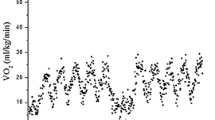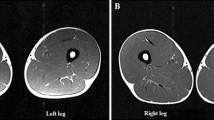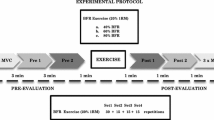Abstract
Purpose
This study aimed to examine the effect of acute blood flow restriction during the late recovery phase between two resistance exercise bouts on muscular endurance and oxygenation.
Methods
Amateur male middle- and long-distance runners performed two bouts of one-leg dynamic plantar flexion exercise to failure with the load equivalent to 75% of maximum. Subjects were randomly assigned into two experimental groups with thigh occlusion pressure between bouts at either 120 or 200 mmHg with 20 min of passive rest in between, and two control groups without any blood flow restriction separated by either 5 or 20 min of rest. Blood flow restriction in the experimental groups was implemented during the last 15 min of recovery. Calf arterial blood flow and muscle oxygenation were measured by venous occlusion plethysmography and near-infrared spectroscopy, respectively.
Results
Decrease of muscular oxygenation and blood flow during recovery between exercise bouts depended on the applied occlusion pressure. When compared with bout 1, work capacity in the experimental groups during bout 2 was reduced by 9.3 ± 2.2% with 120 mmHg and by 10.5 ± 3.1% (p < 0.05) with 200 mmHg occlusion pressure. In the control groups, work capacity was restored after 20 min (− 3.9 ± 3.2%, p > 0.05) but not after 5-min recovery (− 20.0 ± 1.8%, p < 0.05).
Conclusions
Blood flow restriction late in recovery after a heavy resistance exercise bout decreased muscle oxygenation and work capacity during the subsequent heavy resistance exercise bout.


Similar content being viewed by others

Abbreviations
- ANOVA:
-
Analysis of variance
- MVC:
-
Maximal voluntary contraction
- N:
-
Newton
- ŋ 2 :
-
Eta squared
- OP:
-
Observed power
- StO2 :
-
Tissue (muscle) oxygen saturation
References
Borne R, Hausswirth C, Bieuzen F (2017) Relationship between blood flow and performance recovery: a randomized, placebo-controlled study. Int J Sports Physiol Perform 12(2):152–160. https://doi.org/10.1123/ijspp.2015-0779
Burger HC, Horeman HW (1959) Physical properties of some volume recorders in plethysmography. Phys Med Biol 4:176–181
Cook CJ, Kilduff LP, Beaven CM (2014) Improving strength and power in trained athletes with 3 weeks of occlusion training. Int J Sports Physiol Perform 9(1):166–172. https://doi.org/10.1123/ijspp.2013-0018
Dankel SJ, Buckner SL, Jessee MB, Mattocks KT, Mouser JG, Counts BR, Laurentino GC, Abe T, Loenneke JP (2016) Post-exercise blood flow restriction attenuates muscle hypertrophy. Eur J Appl Physiol 116(10):1955–1963. https://doi.org/10.1007/s00421-016-3447-2
Dankel SJ, Buckner SL, Jessee MB, Mattocks KT, Mouser JG, Counts BR, Laurentino GC, Loenneke JP (2017) Can blood flow restriction augment muscle activation during high-load training? Clin Physiol Funct Imaging. https://doi.org/10.1111/cpf.12414
de Ruiter CJ, Goudsmit JF, Van Tricht JA, de Haan A (2007) The isometric torque at which knee-extensor muscle reoxygenation stops. Med Sci Sports Exerc 39(3):443–453. https://doi.org/10.1249/mss.0b013e31802dd3cc
Grunovas A, Silinskas V, Poderys J, Trinkunas E (2007) Peripheral and systemic circulation after local dynamic exercise and recovery using passive foot movement and electrostimulation. J Sports Med Phys Fitness 47(3):335–343
Gundermann DM, Fry CS, Dickinson JM, Walker DK, Timmerman KL, Drummond MJ, Volpi E, Rasmussen BB (2012) Reactive hyperemia is not responsible for stimulating muscle protein synthesis following blood flow restriction exercise. J Appl Physiol (1985) 112(9):1520–1528. https://doi.org/10.1152/japplphysiol.01267.2011
Kalliokoski KK, Knuuti J, Nuutila P (2005) Relationship between muscle blood flow and oxygen uptake during exercise in endurance-trained and untrained men. J Appl Physiol 98(1):380–383. https://doi.org/10.1152/japplphysiol.01306.2003
Laurentino G, Ugrinowitsch C, Aihara AY, Fernandes AR, Parcell AC, Ricard M, Tricoli V (2008) Effects of strength training and vascular occlusion. Int J Sports Med 29(8):664–667. https://doi.org/10.1055/s-2007-989405
Loenneke J, Balapur A, Thrower A, Barnes J, Pujol T (2012) Blood flow restriction reduces time to muscular failure. Eur J Sport Sci 238–243
Patterson SD, Ferguson RA (2010) Increase in calf post-occlusive blood flow and strength following short-term resistance exercise training with blood flow restriction in young women. Eur J Appl Physiol 108(5):1025–1033. https://doi.org/10.1007/s00421-009-1309-x
Suga T, Okita K, Takada S, Omokawa M, Kadoguchi T, Yokota T, Hirabayashi K, Takahashi M, Morita N, Horiuchi M, Kinugawa S, Tsutsui H (2012) Effect of multiple set on intramuscular metabolic stress during low-intensity resistance exercise with blood flow restriction. Eur J Appl Physiol 112(11):3915–3920. https://doi.org/10.1007/s00421-012-2377-x
Takarada Y, Takazawa H, Ishii N (2000a) Applications of vascular occlusion diminish disuse atrophy of knee extensor muscles. Med Sci Sports Exerc 32(12):2035–2039
Takarada Y, Takazawa H, Sato Y, Takebayashi S, Tanaka Y, Ishii N (2000b) Effects of resistance exercise combined with moderate vascular occlusion on muscular function in humans. J Appl Physiol (1985) 88(6):2097–2106
Taylor CW, Ingham SA, Ferguson RA (2016) Acute and chronic effect of sprint interval training combined with postexercise blood-flow restriction in trained individuals. Exp Physiol 101(1):143–154. https://doi.org/10.1113/EP085293
Teixeira EL, Barroso R, Silva-Batista C, Laurentino GC, Loenneke JP, Roschel H, Ugrinowitsch C, Tricoli V (2017) Blood flow restriction increases metabolic stress but decreases muscle activation during high-load resistance exercise. Muscle Nerve. https://doi.org/10.1002/mus.25616
Yamada E, Kusaka T, Tanaka S, Mori S, Norimatsu H, Itoh S (2004) Effects of vascular occlusion on surface electromyography and muscle oxygenation during isometric contraction. Eur J Appl Physiol 13:287–299
Author information
Authors and Affiliations
Corresponding author
Ethics declarations
Conflict of interest
The authors have no conflicts of interest to declare.
Additional information
Communicated by William J. Kraemer.
Rights and permissions
About this article
Cite this article
Bunevicius, K., Grunovas, A., Venckunas, T. et al. Blood flow restriction late in recovery after heavy resistance exercise hampers muscle recuperation. Eur J Appl Physiol 118, 313–320 (2018). https://doi.org/10.1007/s00421-017-3771-1
Received:
Accepted:
Published:
Issue Date:
DOI: https://doi.org/10.1007/s00421-017-3771-1



